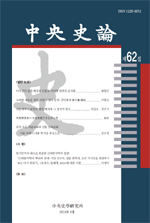대한제국기 중앙군 병영 배치와 그 정치적 함의
Arrangements and Implications of the Central Military barracks during the Korean Empire
- 중앙대학교 중앙사학연구소
- 중앙사론
- 제62집
-
2024.0897 - 134 (38 pages)
-
DOI : 10.46823/cahs.2024.62.97
- 21

갑오개혁 이후근대화된 신식군대 병영의 배치 양상은 고종의 정치적주도권의 소장과 긴밀하게 연동되어 있었다. 갑오개혁기 고종의 정치적 영향력이 위축된 가운데 진행된 군제 개혁의 결과, 새롭게 설치된 조선의 중앙군(훈련대)은 고종이 머무르던 경복궁에서 멀리 떨어진 종묘 주변에 병영을 두었다. 아관파천으로 고종이 정치적 주도권을 다시 장악하면서 중앙군 병영은 경복궁 일대로 중심을 이동하였다. 이후 경운궁으로 환궁한 고종은 자신의 친위부대로 시위대를 창설하고, 대한제국 선포와 함께 친위대와 시위대를 양대 축으로 하는 중앙군의 증설에 나섰다. 그리고 고종의 전제 황권 확립 과정에서 원수부가 황궁에 설치되면서 중앙군의 병영은 황궁인 경운궁을 중심으로 배치되었다. 러일전쟁 이후 일본군이 서울에 주둔하고 대한제국군에 대한 대규모 군축이 진행되면서 군에 대한 고종의 영향력은 급격히 약화되었다. 군축으로 빈 병영은 일본군이 접수하였고, 그 결과 대한제국군은 도성 중심에 고립되었다. 이러한 군영의 이동은 군대 해산 때 대한제국군이 무기력하게 해산 당하는 하나의 원인이 되었다.
After the Gabo Reform, the arrangement of modernized military barracks was closely linked to King Gojong's political leadership. As a result of the military reform, which took place amid the shrinking political influence of King Gojong during the Gabo Reform, the newly established Central Army (Hullyeon-dae) placed a barracks around the Jongmyo Shrine, far from Gyeongbok Palace, where King Gojong resided. As King Gojong regained political leadership with escape to Russian embassy, the barracks of the Central Army shifted their focus to Gyeongbok Palace. After returning to Gyeongun Palace, King Gojong established the Siwi-dae as his own guard corps, and along with the declaration of the Korean Empire, he began to increase the Central Army with the Chinwi-dae and the Siwi-dae as its two main axes. In addition, in the process of establishing Emperor Gojong's absolute imperial authority, the Military Headquarters (Wonsubu) were established in the palace, and the barracks of the Central Army were placed around Gyeongun Palace. After the Russo-Japanese War, Emperor Gojong's influence on the military rapidly weakened as Japanese troops were stationed in Seoul and large-scale disarmament of the Korean Imperial Army proceeded. The Japanese military took over the empty barracks due to disarmament, and as a result, the Korean Imperial Army was isolated in the center of the capital. This relocation of military barracks was one of the reasons why the Korean Imperial Army was disbanded so helplessly when the army was disbanded.
Ⅰ. 머리말
Ⅱ. 갑오개혁기 왕권의 위축과 중앙군의 배치
Ⅲ. 아관파천과 중앙군 체제의 변화
Ⅳ. 전제황권의 구축과 중앙군의 증설
Ⅴ. 러일전쟁 이후 일본군의 주둔과 중앙군 병영의 이전
Ⅵ. 맺음말
(0)
(0)